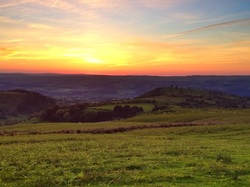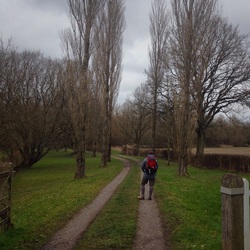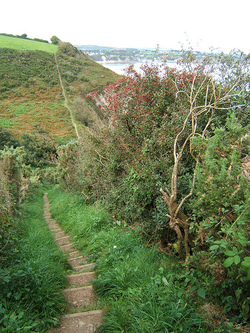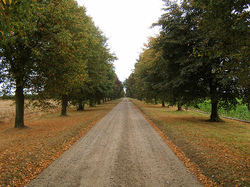 Sunset from Hay Bluff, Wales.
Sunset from Hay Bluff, Wales. When I talk about our walking holidays (i.e. frequently), people often ask, "How do you know where to walk?" and "How do you find these places?" They seem uncertain how to even start planning such an expedition. Well, this is how. I hope sharing these tips encourages others (who are able) to get out and do multi-day walks, too.
Location and/or type of walk
My partner and I have done multi-day walks on National Trails, long distance paths, self-designed routes, dismantled railway lines, canal paths, coast paths and combinations of the above. You might decide on a far-flung corner of the country, or go for something closer to home to save on transport time and cost.
How long (days) and how long (distance)?
 A winter walk in Kent.
A winter walk in Kent. We also know how far we like to walk in a day. For us, 16km/10mi is an easy day over everything but the hilliest landscape, even with a full pack. 20km/12mi is a good day for us and we wouldn’t aim to do more than that if the going was rough. 25km/15mi is about our upper limit for a comfortable/pleasant day of walking, especially if it’s a week-long hike in the short daylight hours of winter.
It’s worth factoring in rest days if you’re doing a longer walk, so you can explore local attractions, wash your clothes, edit your photos or stay in bed all day if that’s your thing. Everyone’s capabilities and preferences are different.
Map a route
 Southwest Coast Path, Cornwall.
Southwest Coast Path, Cornwall. In the UK, Ordnance Survey 1:25000 maps (Explorer range) are the best for walking. If you're not sure how to read OS maps, here are some keys.
To plan a walk, I usually use the Walk Highlands GPS planner (it’s free to sign up and access the 1:25000 OS maps there). Sometimes I plot a straight line between my start point and goal, then gradually put in mid points; sometimes I start with straight lines between towns/villages about 10-20km apart (more likely to have accommodation) and see where I end up before zooming in to the 1:25000 map and plotting a course along public paths, permissive routes and minor roads.
Find and book accommodation
Finding accommodation providers is generally pretty easy in the UK, but sometimes everything in a village is booked out (and frequently B&Bs will have a minimum two night stay on the weekend). If this happens, I start rearranging the route. For this reason, I always book the first night of the walk first and don’t book the next place until I’ve reserved/paid a deposit. The days of rocking up unannounced and finding a bed have pretty much disappeared anywhere other than major tourist towns or cities – we always book ahead.
Gather resources
- Maps: I like having weatherproof hard copies (e.g Aqua3) as well as a GPX file for the phone - sometimes we buy them and sometimes we hire them from the Ramblers (if you like walking in the UK, consider becoming a Ramblers member - I am).
- Transport: Get tickets and/or timetables for public transport, car park info, relevant taxi numbers, etc.
- Accommodation: A list of phone numbers and addresses for all accommodation, along with payment info (deposit paid, amount owing, whether they take cards). I usually call the week before to confirm, especially as we have extra requirements (we’re both vegetarian).
- Clothes and accessories: I’ll re-waterproof my boots/jacket if needed and maybe write a packing checklist – I don’t want to be stuck without spare socks after a downpour!
- Gear: Have you got everything you need? Is it in good nick? This might include back pack, first aid kit, thermos, devices and chargers, poles and camping gear.
- Info: You could buy/borrow a trail guide if you’re on an established way, or research places of interest and create your own booklet (nerds unite - I love doing this!).
Preparation and training
 An autumnal path in Essex.
An autumnal path in Essex. - Distance: Do a day walk covering the longest distance you’ll be hiking during your holiday – if possible, over similar terrain – so you know you can do it.
- Endurance: Do two reasonably long day walks back to back, so you have some idea of what it feels like to get up and go when you’re still a bit achy. (Camp overnight if you’re planning this on your walk so you can fix any issues with your set-up.)
- Strength: Fill your backpack with your gear or equivalent weight and take it out on your day walks, both to get used to the weight and to get a feel of how to pack/adjust your bag.
Good luck and happy walking!

 RSS Feed
RSS Feed
